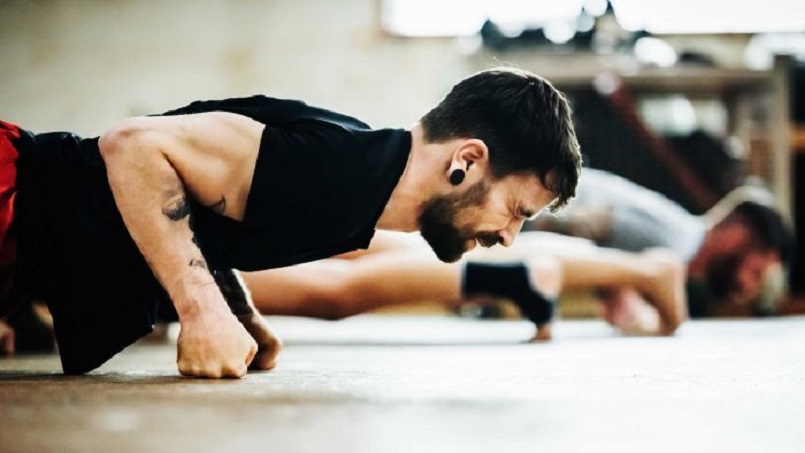
Exercise is really, really important.
You only have to look at what happens when you don't do it to see why.
But physical activity also comes with its fair share of aches and pains — and there's no denying that sometimes it can hurt.
If we were to stop working out at the first sign of discomfort, however, we'd probably never do any exercise at all.
So when it comes to keeping fit, when do you tell yourself to stop griping and keep going — and when should you actually rest?
Discomfort versus pain
Carly Ryan, exercise physiologist at Exercise and Sports Science Australia, says it's important to differentiate between "pain" and "discomfort" when working up a sweat.
"Effort and discomfort go together and that's what most people would call good pain — you generally expect to feel some level of discomfort," Ms Ryan explains.
"If it becomes actual pain — burning or stabbing or sharp — that's not a good sign and you should stop."
Dr Nathan Johnson, associate professor of exercise and sports science at the University of Sydney, says while discomfort from feeling fatigue during exercise is normal, acute pain associated with injury or illness is not.
"If you're feeling joint or musculoskeletal pain, or anything associated with chest pain, then that's an indication to stop exercising immediately," Dr Johnson says.
Knowing the difference
Both Ms Ryan and Dr Johnson agree the easiest way to tell if you are feeling pain or discomfort is to just cease the exercise.
"A little bit of a burn that goes away when your muscles stop working is often just a result of the exercise, so it's OK to continue," Ms Ryan says.
"But if it continues and you're getting, say, a sharp pain in your knees or you feel a painful twinge in your hamstrings that affects your ability to keep moving, then it's most likely pain because you've overdone it, so you need to stop."
What is 'good pain'?
Good pain — or discomfort — according to sport and exercise physician Dr Andrew Jowett, reflects positive change in the body, and is part of the body's adaption to an activity or physical load.
"What we know about muscle adaption to [physical] loads is that when you put it under load or under stress, you actually cause microscopic injury to the muscle," Dr Jowett says.
"That injury stimulates muscle healing and hopefully replication of muscle fibres and ultimately strengthening.
"So that's the good sort of pain we're after out of any workout — to prevent injuries or to improve our performance."
The chairman of Sports Medicine Australia says what's important is that you give your body some time to recuperate.
"So backing up a load straight afterwards or the next day, you might go down the slope and cause further damage that you don't improve from," he says.
Lactic acid
One of the most common forms of pain or discomfort we feel during strenuous exercise is a burning sensation in our lungs or muscles that goes away shortly after we cease the activity. This is caused by a build-up of lactic acid.
Lactic acid is a by-product of the process your body goes through when it needs to create energy more quickly than it normally does, such as when you exercise.
Your working muscles usually generate energy aerobically (i.e. using oxygen), but when you push yourself during a workout and sufficient oxygen isn't available, these muscles start generating energy anaerobically, and lactic acid is a by-product of this process.
The harder you work, the bigger the build-up of lactic acid. The fitter you are, however, the better your body will be at clearing the lactic acid, so eventually you'll be able to train harder for longer.
Serious athletes train to push through intense burning, but Ms Ryan says for us mere mortals, continue as long as you're able to breathe regularly and aren't feeling any pain in your joints or sharp twinges in your muscles.
"We want people to push themselves a little bit outside of their comfort zone, but if it's starting to feel wrong and you're questioning it, then you're better off stopping and seeking the advice of an appropriately qualified exercise professional," she says.
Delayed onset muscle soreness
If you've ever done a gruelling workout after you've had some time off from exercise, chances are you were feeling a bit sore and sorry for yourself a few days after.
This is called delayed-onset muscle soreness (DOMS), and is your body's way of letting you know you've done something it's not used to.
"It should ease off over the next couple of days, but if it doesn't and you're finding it hard to sit or move, it probably suggests you've done too much," Ms Ryan explains.
Although sitting on the couch until it goes away is appealing, the best way to overcome DOMS is with light exercise.
"A gentle walk or swim — with less intensity than what caused the DOMS — will reduce the pain and speed up the recovery process," Ms Ryan says.
"The blood flow to your muscles will help them repair and improve flexibility and mobility."
Preventing pain
Getting the level of exercise just right to prevent excessive discomfort might take a bit of trial and error.
"It doesn't matter what kind of exercise you're doing, if it feels like it's too much for your body, just ease off," Ms Ryan says.
"It's completely normal to do a slightly modified move or less than what you've been instructed to do, if you're in a class. You'll still get great benefits without doing the whole range of movement."
